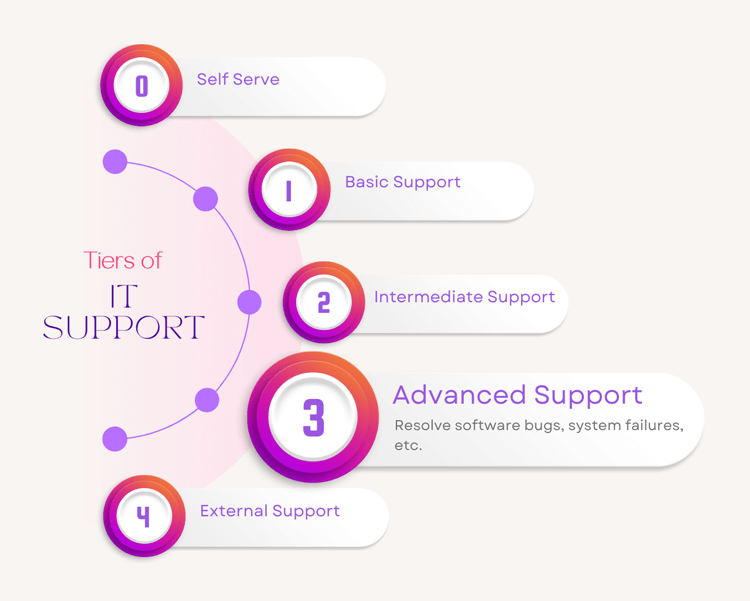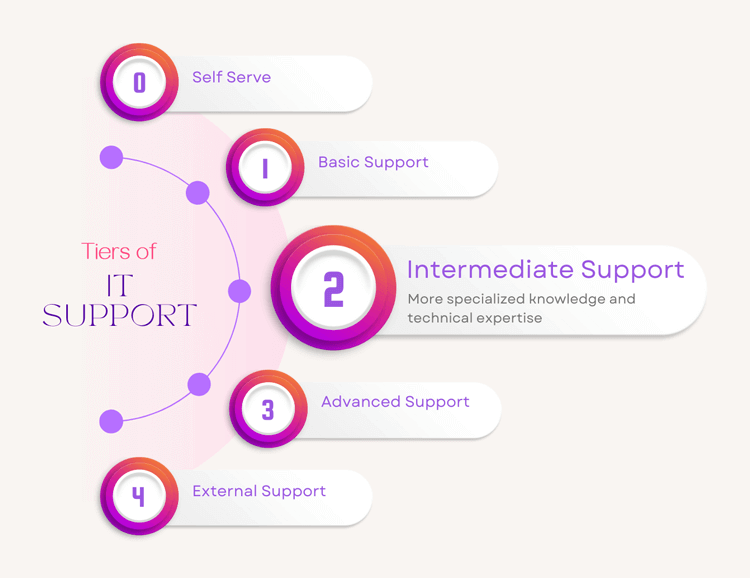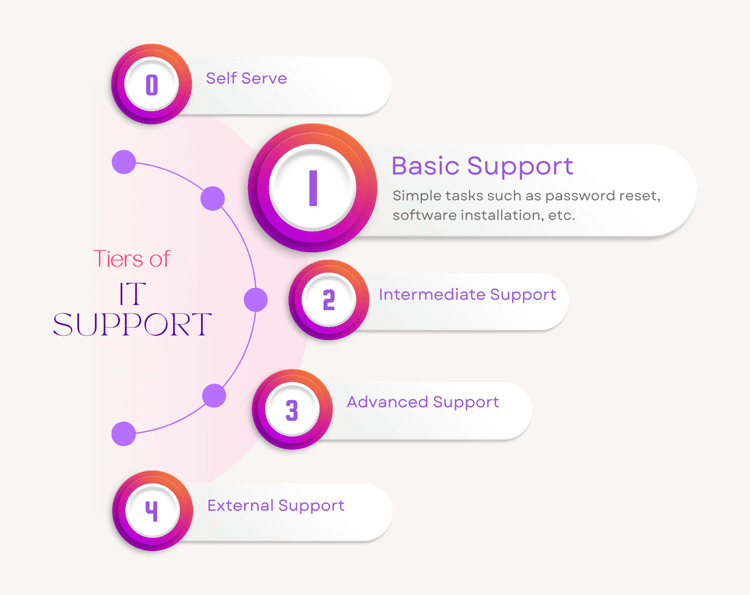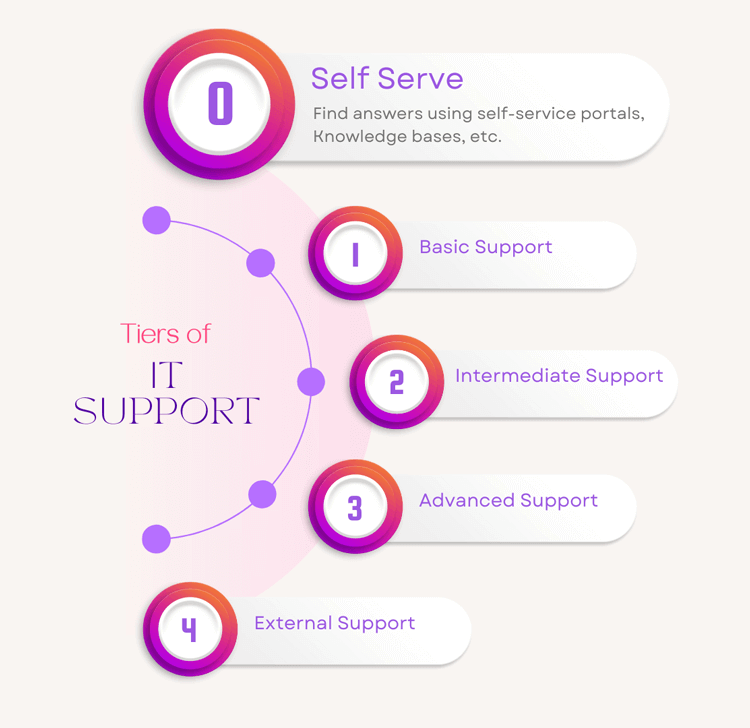Tier 3 IT Support Fully Explained: Level 3 Tech Support
Tier 3 IT Support, also known as Level 3 IT Support, represents the highest level of internal technical support within an IT service management (ITSM) team.
Tier 3 includes only the most experienced and knowledgeable IT help desk staff members. This often includes platform specialists and experts, developers, and engineers who specialize in specific areas of the IT infrastructure.

TL;DR
- Accessing ITIL user support, usually by submitting a support ticket via help desk software, goes to one of 4 levels of support.
- Level 3, also known as Tier 3, is the highest level of IT support ITSM organizations usually retain in-house. Even if you work with an external IT vendor, it's unlikely they will have the level above this (Tier 4/Level 4) on the payroll.
-
Tier 3 takes a very active role in:
- IT and digital strategies
- Any in-house software development projects
- Working with IT vendors
- The management of an organization's IT budget
- Digital security
Read on for details...
What is Tier 3 IT Support (Level 3)?
Tier 3 IT Support, often referred to as Level 3, is the highest in-house layer of IT service management (ITSM). Whether delivered by an organization's IT department or a third-party IT customer service team/vendor, having Tier 3 support solves the most complex issues that users/customers within an organization can encounter.
This tier is responsible for handling the most complex and critical issues that Tier 1 and Tier 2 support teams are unable to resolve.
Tier 3 support often involves in-depth troubleshooting, root-cause analysis, system integration, and bug fixing. These experts may also be involved in proactive activities such as:
- System optimization
- Digital transformation
- Systems design
- Implementation of advanced IT solutions
Why Does Tier 3 IT Support (Level 3) Play a Critical Role in ITSM and Help Desks?
Tier 3 IT Support plays a vital role in ITSM and help desks because it is the last line of defense in the support structure. When lower tiers are unable to resolve an issue, it is escalated to Tier 3, where highly skilled professionals work to find a solution. This tier's expertise is critical in resolving complex issues that could have significant impacts on the organization's operations.
Tier 3 also contributes to continuous improvement by identifying and addressing underlying issues that cause recurring problems. The insights and solutions provided by Tier 3 can lead to system improvements, reducing the frequency and severity of incidents over time. Additionally, Tier 3 plays a key role in knowledge transfer, helping to train and guide Tier 1 and Tier 2 teams.
Including Tier 3 in an ITSM framework ensures that the most complex issues don't completely cripple an organization.
Tier 3 support also allows IT teams to allocate resources more efficiently by focusing their attention on critical incidents and strategic initiatives. When ITSM teams and ITIL operators keep the resolution of simple, repetitive troubleshooting tasks to Self-serve, Tier 1 (or 2), help desk teams can reduce operational costs and improve overall service levels and customer service scores (e.g., CSAT, NPS, etc.).
Pros and Cons of ITSM Tier 3 IT Support
With five tiers of IT support, from self-serve to the most advanced technical support, your organization will benefit from having all five tiers to support your staff. Here are the pros and cons of Tier 3.
Pros of Tier 3 IT Support
- Expertise in Complex Problems: Tier 3 support offers deep technical knowledge and advanced problem-solving skills. This is essential for resolving the most challenging IT issues.
- Root Cause Analysis: This tier excels at identifying the root causes of recurring problems. These analyses can lead to long-term solutions and major improvements in IT systems. It can involve developing new software, and platforms, or buying new devices, or even improving processes, systems, and security.
- Involvement in Strategic IT Initiatives: Tier 3 professionals often contribute to system design, implementation, and optimization. This can drive innovation and efficiency within the IT infrastructure.
- Reduction in Escalations: By resolving issues effectively at this level, Tier 3 reduces the need for external escalation (known as Level 4). This can help maintain control over IT processes and solutions.
- Knowledge Sharing and Training: Tier 3 teams often provide training and knowledge-sharing opportunities to lower-tier support staff, enhancing overall support capabilities.
Cons of Tier 3 IT Support
- High Costs: Tier 3 support requires highly skilled IT staff with coding skills who expect to be paid higher salaries (in line with market demand for those skills). This can make it the most expensive tier of internal support.
- Potential Bottlenecks: When too many issues are escalated to Tier 3, it can become a bottleneck, leading to delays in issue resolution.
- Limited Availability: Given their specialized skills, Tier 3 technicians may be a very small team (or even just one person). That can make it difficult to scale support when demand is high.
- Dependency on Detailed Documentation: Tier 3 relies heavily on accurate and comprehensive documentation from Tier 1 and Tier 2 if an issue has been escalated upwards. Poor documentation can hinder effective problem-solving. Automatic routing to Tier 3 is possible; although, in most cases, escalation has to be done manually due to the complexity of the issues.
- Longer Resolution Times for Complex Issues: While Tier 3 is equipped to handle complex issues, the nature of these problems often requires more time to diagnose and resolve. Naturally, the KPIs within SLAs are extended accordingly to align with these more complex needs.
Now let's look at how to set up Tier 3 ITSM support, which involves recruiting highly-skilled IT staff and implementing the resources required for this level of support.
How to Set Up Tier 3 IT Support: 5 Stages for an IT Help Desk
In most cases, setting up Tier 3 IT Support involves 5 stages, and it's equally important to maintain these resources once they're established.
- Define the Role and Responsibilities: Clearly outline the scope of Tier 3 support, focusing on complex issue resolution, root cause analysis, and advanced system tasks. Document the types of issues Tier 3 will handle, ensuring a clear distinction from Tier 2 or Tier 4 responsibilities.
- Recruit and Retain Highly Skilled IT Developers: Hire or promote individuals with deep technical expertise and experience in the specific technologies and systems used by your organization. Invest in ongoing training and professional development to keep their skills up-to-date.
- Implement Advanced Tools and Resources: Provide Tier 3 support staff with access to advanced diagnostic tools, system logs, and specialized software. These will help them to perform in-depth troubleshooting and analysis.
- Establish Escalation and Documentation Protocols: Develop detailed escalation procedures that ensure only the most complex issues reach Tier 3. Encourage thorough documentation at every support level to aid Tier 3 in quickly understanding and resolving issues.
- Promote Collaboration and Knowledge Sharing: Encourage Tier 3 staff to collaborate with lower-tier teams, providing guidance and sharing knowledge. This can be achieved through regular training sessions, documentation updates, and cross-tier communication channels.
How Does Tier 3 Compare to Other ITSM Support Tiers?
For more information on every tier of IT support, here is our 5 Tiers of IT Support Explained: Tier 0 to Tier 4, ultimate guide.
Tier 3 vs Tier 0 (Self-Serve)
Tier 0 is user-driven, relying on self-service tools and resources, while Tier 3 involves expert intervention for resolving complex technical issues. Tier 0 focuses on empowering users, whereas Tier 3 focuses on high-level problem solving and system improvements.
For more information on Tier 0, self-serve support, here's our article on Tier 0 (Level 0) IT Support.
Tier 3 vs Tier 1
Tier 3 support is for more complex issues that require deeper technical knowledge and expertise.
While Tier 1 handles simple, routine troubleshooting as the front-line of every IT help desk, Tier 3 IT staff handle and solve problems that require more advanced and specialized knowledge.
For more information on Tier 1 support, here's our article on Tier 1 (Level 1) IT Support.
Tier 3 vs Tier 2
Tier 3 is typically reserved for issues that require high-level technical skills, such as bug fixes, advanced platform knowledge (e.g., AWS, Google, Microsoft, Intel, etc.), and system integration tasks.
Tier 2 focuses on solving less complex technical challenges; although ones that are still more complex than Tier 1 can handle.
With level 3 support, IT staff are involved in strategic decisions and implementations, such as digital transformation, platform migrations, and in-house software development.
For more information on Tier 2 support, here's our article on Tier 2 (Level 2) IT Support.
Tier 3 vs Tier 4
Tier 4 always involves coordinating with external vendors and consultants who attempt to solve issues beyond the internal IT team's capabilities. In contrast, Tier 3 is significantly complex but entirely user-driven and focused on common, internal support needs.
For more information on Tier 4 support, here's our article on Tier 4 (Level 4) IT Support.
How Do Different Tiers of IT Support Work Together to Make a Functional ITSM Team?
The different tiers of IT support work together to create a seamless, efficient support ecosystem.
Tier 0 empowers users to solve their own problems, reducing the burden on IT staff.
Tier 1 serves as the first point of contact, handling basic issues and escalating more complex ones to Tier 2.
Tier 2 tackles intermediate challenges and escalates the most difficult cases to Tier 3.
Tier 3, with the most skilled technicians, tackles the most complex and critical issues, sometimes working with Tier 4 (external support) when necessary. This structure allows for efficient problem resolution, optimized use of resources, and continuous improvement in IT service delivery.
Key Takeaways: Why Your Organization Needs Tier 3 IT Support
Tier 3 IT support is crucial for managing the most complex and impactful technical issues within an organization. With a dedicated team of experts to handle advanced problems, your organization can ensure that even the most challenging issues are resolved effectively, minimizing downtime and maintaining system stability.
Tier 3 also contributes to strategic IT initiatives, helping to drive innovation and optimize systems. Implementing a robust Tier 3 support structure is essential for organizations that want to maintain a high level of IT service quality and ensure that their IT infrastructure remains resilient and efficient.
Giva Can Help Streamline Your Tier 3 IT Support
Giva's help desk and ITSM software bring you real-time, highly-customizable dashboards with a large widget library. You'll be up and running in days, and your IT help desk and service desk teams can be trained in hours on our intuitive and friendly interface.
Other Giva features include:
- Harness the power of Giva's AI Copilot to effortlessly refine responses and quickly access and format solution information
- Automatically convert emails into tickets to streamline the ticketing process
- Customize Giva for any department or subsidiary organization and deliver real-time agent and team analytics to help improve performance
- Automatically open tickets on a scheduled and recurring basis
- Automate escalation and closure of tickets
To learn more, book a free Giva demo to see our solutions in action, or start your own free, 30-day trial today!





